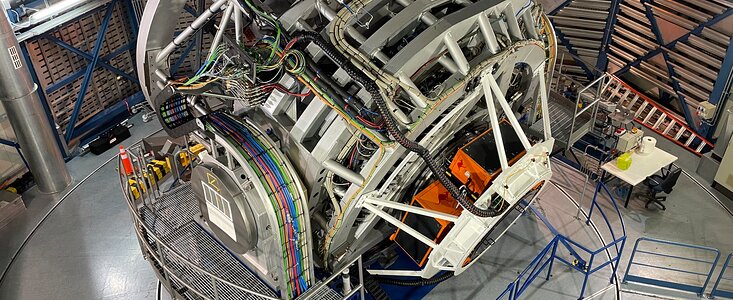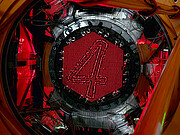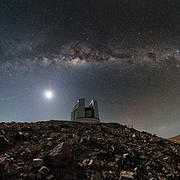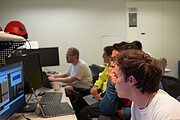Meddelande
Tusen ögon mot himlen: 4MOST:s första observationer
21 oktober 2025
Under helgen slutfördes de första testobservationerna med det nya instrumentet 4-meter Multi-Object Spectroscopic Telescope (4MOST). 4MOST är installerat på Visible and Infrared Survey Telescope for Astronomy (VISTA), ett ESO-teleskop i Chile, och är det största instrumentet i sitt slag för att kartlägga den södra himlen. Under sina första fem år i drift kommer det att fånga och analysera ljuset från över 25 miljoner objekt i syfte att bland annat nysta upp Vintergatans galaktiska historia, utforska den mörka materian och undersöka stjärnornas ursprung.
Instrument är utformat för att fånga ljuset från tusentals objekt samtidigt med hjälp av mer än 2400 tunna optiska fibrer, var och en ungefär lika breda som ett mänskligt hårstrå. Detta ljus riktas sedan till tre separata spektrografer som delar upp det i 18 000 färgkomponenter (från violett till rött ljus), vilket skapar spektra av varje objekt. Med hjälp av dessa kan astronomer analysera egenskaperna hos de observerade kosmiska källorna, inklusive deras kemiska sammansättning, hastighet och avstånd.
"Astronomer har länge efterfrågat en anläggning som 4MOST", säger Joar Brynnel, projektledare för 4MOST vid Leibniz-institutet för astrofysik Potsdam (AIP), Tyskland, det institut som ledde instrumentkonsortiet. Antalet objekt som kan observeras, det stora synfältet (motsvarande 16 fullmånar) och det stora antalet spektrala färger som den kan registrera samtidigt gör instrumentet unikt.
"Detta är en stor förändring av hur vi arbetar på ESO. Vanligtvis när man observerar man målen för en vetenskaplig studie ett objekt i taget", säger Vincenzo Mainieri, projektforskare för 4MOST på ESO. Men på grund av det stora antalet fibrer kan instrumentet observera källor för många vetenskapliga projekt samtidigt. Han fortsätter: ”4MOST kan utföra 10 eller fler vetenskapliga studier parallellt i en enda observation. Det är ett sätt att maximera instrumentets vetenskapliga resultat.”
Denna banbrytande anläggning kommer inte bara att belysa förhållandena i vår egen hemgalax utan också titta längre bort för att sammanställa hur andra galaxer bildas och utvecklas. Genom att observera avlägsna galaxer kommer 4MOST också att hjälpa oss att bättre förstå mörk materia, en osynlig form av materia som genomsyrar galaxerna och rymden mellan dem. Instrumentet kommer också att användas för att studera universums utveckling, dess expansion och hur denna förändras över tid.
4MOST har ersatt VISTA Infrared Camera (VIRCAM), som har genomfört observationer med VISTA-teleskopet sedan 2008. Eftersom 4MOST är en spektrograf, ett instrument som är fundamentalt annorlunda än en kamera, behövde VISTA uppgraderas helt. ”Vi var tvungna att byta ut ett stort antal komponenter i teleskopet för att få plats med vårt instrument, vilket gav teleskopet ny stor optik, nya teknikkameror för att styra teleskopet och även själva instrumentet”, säger Brynnel. ”Uppgraderingen av VISTA-teleskopet för att ta emot de nya komponenterna förbereddes av ESO inför 4MOST:s ankomst”, förklarar Jean-François (Jeff) Pirard, ESO-projektledare för 4MOST. ”Teleskopet togs i bruk igen under första halvåret 2025, precis i tid för att montera det nya 4MOST-instrumentet.”
Premiärobservationerna med 4MOST, som täckte ett område på himlen som innehöll Sculptorgalaxen och stjärnhopen NGC 288, visar instrumentets banbrytande förmåga att observera många objekt med ett förvånansvärt stort synfält och många optiska fibrer. I den första omgången samlade 4MOST in spektra både av stjärnor i Vintergatan och av över tusen galaxer nära och fjärran, vilket demonstrerar dess imponerande kapacitet.
4MOST:s forskningsansvarige astronom Roelof de Jong, chef för Vintergatans sektion på AIP, kommenterar: ”Det är otroligt att se de första spektrumen tagna med vårt nya instrument. Datan ser fantastisk ut och bådar gott för alla de vetenskapliga projekt vi vill genomföra. Att vi kan fånga ljus som ibland har färdats i miljarder ljusår till en glasfiber stor som ett hårstrå är häpnadsväckande och en otrolig bedrift som bara har varit möjligt tack vare en otrolig utvecklingsgrupp. Jag längtar tills systemet är igång varje natt.”
Mer information
4MOST-anläggningen är designad, byggd och vetenskapligt driven av ett konsortium av 30 universitet och forskningsinstitut i Europa och Australien under ledning av Leibniz-institutet för astrofysik i Potsdam (AIP). De huvudsakliga instituten som varit involverade i byggandet och driften av anläggningen är:
- Leibniz-institutet för astrofysik Potsdam (AIP), Tyskland
- Macquarie University / Australian Astronomical Optics (AAO), Australien
- Centre de Recherche Astrophysique de Lyon (CRAL), Frankrike
- Europeiska sydobservatoriet (ESO)
- Max Planck-institutet för astronomi (MPIA), Tyskland
- Max Planck-institutet för extraterrest fysik (MPE), Tyskland
- Nederlandse Onderzoekschool Voor Astronomie (NOVA), Nederländerna
- University of Cambridge, Institute of Astronomie (IoA), Storbritannien
- Universität Hamburg (UHH), Hamburger Sternwarte, Tyskland
- Universität Heidelberg, Zentrum für Astronomie (ZAH), Tyskland
Länkar
Om meddelandet
| ID: | ann25007 |
Our use of Cookies
We use cookies that are essential for accessing our websites and using our services. We also use cookies to analyse, measure and improve our websites’ performance, to enable content sharing via social media and to display media content hosted on third-party platforms.
ESO Cookies Policy
The European Organisation for Astronomical Research in the Southern Hemisphere (ESO) is the pre-eminent intergovernmental science and technology organisation in astronomy. It carries out an ambitious programme focused on the design, construction and operation of powerful ground-based observing facilities for astronomy.
This Cookies Policy is intended to provide clarity by outlining the cookies used on the ESO public websites, their functions, the options you have for controlling them, and the ways you can contact us for additional details.
What are cookies?
Cookies are small pieces of data stored on your device by websites you visit. They serve various purposes, such as remembering login credentials and preferences and enhance your browsing experience.
Categories of cookies we use
Essential cookies (always active): These cookies are strictly necessary for the proper functioning of our website. Without these cookies, the website cannot operate correctly, and certain services, such as logging in or accessing secure areas, may not be available; because they are essential for the website’s operation, they cannot be disabled.
Functional Cookies: These cookies enhance your browsing experience by enabling additional features and personalization, such as remembering your preferences and settings. While not strictly necessary for the website to function, they improve usability and convenience; these cookies are only placed if you provide your consent.
Analytics cookies: These cookies collect information about how visitors interact with our website, such as which pages are visited most often and how users navigate the site. This data helps us improve website performance, optimize content, and enhance the user experience; these cookies are only placed if you provide your consent. We use the following analytics cookies.
Matomo Cookies:
This website uses Matomo (formerly Piwik), an open source software which enables the statistical analysis of website visits. Matomo uses cookies (text files) which are saved on your computer and which allow us to analyze how you use our website. The website user information generated by the cookies will only be saved on the servers of our IT Department. We use this information to analyze www.eso.org visits and to prepare reports on website activities. These data will not be disclosed to third parties.
On behalf of ESO, Matomo will use this information for the purpose of evaluating your use of the website, compiling reports on website activity and providing other services relating to website activity and internet usage.
Matomo cookies settings:
Additional Third-party cookies on ESO websites: some of our pages display content from external providers, e.g. YouTube.
Such third-party services are outside of ESO control and may, at any time, change their terms of service, use of cookies, etc.
YouTube: Some videos on the ESO website are embedded from ESO’s official YouTube channel. We have enabled YouTube’s privacy-enhanced mode, meaning that no cookies are set unless the user actively clicks on the video to play it. Additionally, in this mode, YouTube does not store any personally identifiable cookie data for embedded video playbacks. For more details, please refer to YouTube’s embedding videos information page.
Cookies can also be classified based on the following elements.
Regarding the domain, there are:
- First-party cookies, set by the website you are currently visiting. They are stored by the same domain that you are browsing and are used to enhance your experience on that site;
- Third-party cookies, set by a domain other than the one you are currently visiting.
As for their duration, cookies can be:
- Browser-session cookies, which are deleted when the user closes the browser;
- Stored cookies, which stay on the user's device for a predetermined period of time.
How to manage cookies
Cookie settings: You can modify your cookie choices for the ESO webpages at any time by clicking on the link Cookie settings at the bottom of any page.
In your browser: If you wish to delete cookies or instruct your browser to delete or block cookies by default, please visit the help pages of your browser:
Please be aware that if you delete or decline cookies, certain functionalities of our website may be not be available and your browsing experience may be affected.
You can set most browsers to prevent any cookies being placed on your device, but you may then have to manually adjust some preferences every time you visit a site/page. And some services and functionalities may not work properly at all (e.g. profile logging-in, shop check out).
Updates to the ESO Cookies Policy
The ESO Cookies Policy may be subject to future updates, which will be made available on this page.
Additional information
For any queries related to cookies, please contact: pdprATesoDOTorg.
As ESO public webpages are managed by our Department of Communication, your questions will be dealt with the support of the said Department.








